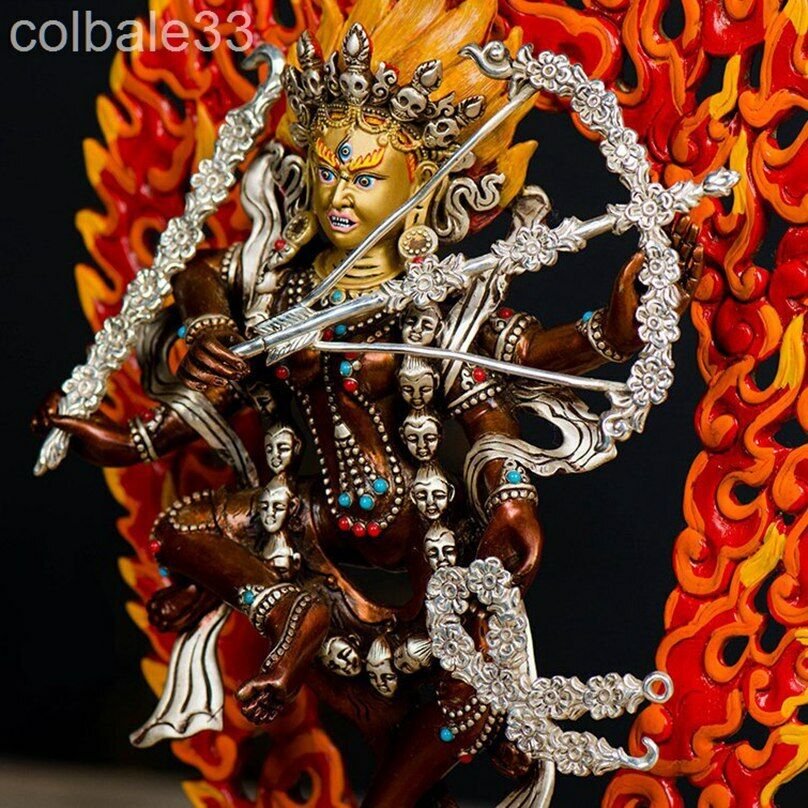Kurukulla: A Pivotal Deity in Sakya Tradition
Kurukulla, known as “Goddess of Wisdom and Action” in Tibetan Buddhism. She is referred to as “Lhamo Rigchima ཀུ་རུ་ཀུ་ལླེ་ “ལྷ་མོ་རིག་བྱེད་མ་ in Tibetan. She holds a significant place within the Sakya school of Tibetan Buddhism. Furthermore, she is one of the “Red Trinity” and integral to the “Thirteen Golden Dharmas,”. It is a unique set of tantric teachings exclusive to the Sakya tradition.

The Essence of Kurukulle: Blending Wisdom with Action
The name “Kurukulle” translates to “Wisdom and Action,” emphasizing the importance of merging wisdom (Prajna) and actions (Karma) in the path to enlightenment. In Buddhism, while Prajna pertains to the wisdom that guides one toward enlightenment, the other five Paramitas (generosity, moral conduct, patience, effort, and meditation) represent action. The harmonious combination of these leads to spiritual attainment.
Kurukulla, as a dakini, embodies ultimate wisdom, dispelling ignorance and transforming negative emotions into pure awareness. She intricately links with the four enlightened activities – pacifying, enriching, magnetizing, and subjugating – in Buddhist tantras, and particularly specializes in attracting favorable conditions and magnetizing.
Kurukulla: A Symbol of Wisdom
Kurukulla, revered as a wisdom deity, transcends conventional roles. Practicing her teachings reportedly grants immunity from natural disasters, diseases, accidents, and spiritual impediments. Her most celebrated attribute involves capturing and taming the minds of sentient beings, propelling them towards spiritual enlightenment.
Her unique ability lies in subduing sensual passions and using them as a tool to reach the higher reality of Dharma. Kurukulla’s enlightened mind, brimming with passion and impassioned loving kindness, lacks selfish intentions and focuses solely on alleviating the suffering of sentient beings through her unconditional love and tenderness.
Kurukulla in Tibetan Culture: The Formidable Protector
In Tibetan cultural beliefs, people also know Kurukulla as “Wangjik Lhamo,” meaning “The Powerful Mother,” emphasizing her critical role in subjugating the spiritual realm and protecting beings from harmful spirits.
Iconographically, Kurukulla carries the traits of Mahayana and Vajrayana female celestials. As described in a 17th-century prayer from the Namcho Cycle by Terton Migyur Dorje, she appears in a ruby color of impassioned loving-kindness, with one face, four arms, and three eyes, gracefully holding a flower bow and arrow, and a magnetizing hook.
Her red color signifies her passion and connection to love, paralleling Greek Aphrodite and Roman Venus. Her bow and arrow, reminiscent of Eros or Cupid, are symbolic. They are tools for attracting and transforming consciousness, symbolizing the victory over selfish desires and dualistic thoughts.

Kurukulla’s Iconography in Thangka Art
Kurukulla is often depicted in Thangka art in a dynamic dancing pose. Her red body symbolizes the Buddha’s activity power to repel evil forces. With one head and four arms, she dons a crown of five skulls and has hair colored in shades of red and yellow, indicating her power to elevate practitioners to enlightenment. Her wrathful facial expression represents the strength of commitment and devotion.
A distinctive aspect of Kurukulla is her independence, not being associated with a male partner, indicating her embodiment of universal and unconditional love, committed universally to all sentient beings.
Kurukulla’s practice offers numerous secular and spiritual benefits, from attracting love and improving relationships to subjugating demonic powers and accumulating wealth. Spiritually, it fosters wisdom, awareness, and compassion, attracting favorable events and people. Ultimately, her power aids in transforming consciousness and achieving enlightenment.
Symbolism of Kurukulla’s Attributes
- Bow and Arrow: In one set of arms, Kurukulla wields an Utpala flower bow and arrow, signifying readiness to shoot. The bow symbolizes meditative focus, while the arrow represents piercing wisdom, denoting the capability to deflect supernatural forces.
- Iron Hook and Noose: Her other arms hold an iron hook and a noose. The hook symbolizes control over wandering thoughts, and the noose awakens dormant wisdom, illustrating the power to capture and manage spirits and supernatural entities.
Kurukulla’s richly symbolic iconography in Thangka paintings not only encapsulates her divine qualities but also serves as a spiritual guide for devotees seeking enlightenment and protection. Her portrayal vividly embodies the fusion of wisdom and action central to Tibetan Buddhist practice.
Recognized in Vajrayana as a fully enlightened being, Kurukulla’s mastery of love in its purest form is her unique power. She exemplifies the transformation of desire and love into spiritual realization, making her a pivotal figure in Buddhist teachings.
